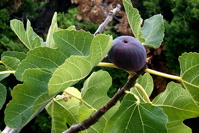First-Timer's Club for 2006
Many of us garden because we love growing things, especially improbable things. And many of us garden to excess because we are enthusiastic, or maybe a bit bonkers. I bought how many kinds of heirloom tomatoes where I can really only grow 5 - 7 tomato plants? You know. That kind of thing. But every year, many of us try to add something different or new to the garden. I call it "joining the first-timer's club".

Often there is a book to blame for a sudden burst of enthusiasm, and that was definitely the case for me. I picked up a used copy of Rosalind Creasy's "The Edible Asian Garden" at Powell's on our fall trip to Portland. After sitting down and reading it, I was buzzing with ideas. I planned on adding everything from amaranth to tsat-tsoi to my garden. Then I got realistic about what I could really grow, and what we'd be likely to actually eat and use. But even after the realism, there were some things that made the cut. Woo-hoo!
Eggplant, long Japanese type
I've always had a fondness for eggplant, especially eggplant parmesan. My hubby has claimed great loathing for eggplant, though, so I haven't tried growing any-- I can satisfy my occasional eggplant cravings with dinner out or a trip to the store. However, Mike recently encountered YuShiang Eggplant (garlic eggplant in brown sauce) and tried some. Aha. He says the long Asian types of eggplant are 'sweeter' and 'milder' than the giant purple Barney Eggs style, and that he would like to try cooking with it at home. So I am going to be growing eggplant for the first time. It's supposedly very much like tomatoes or peppers to grow, so that shouldn't be too difficult. Famous last words!
Daikon, Japanese radish
Ditto for growing daikon, basically a very long radish. I'm going to try to get a short variety, since I have only about a foot of raised bed or less before "Welcome to the World of Clay". I'm encouraged by how soft the soil got in the beds this year, but there are, alas, limits. The daikon I see in the local Ranch 99 and similar is vast and huge, and I hope represents some giant variety rather than the norm. I found a 'Minowase' variety that is supposed to get approximately 2 feet in length and 3 inches in diameter, and that sounds good to me. Some of the daikon I see in the markets is double that size!
One reason in particular that I'd like to grow daikon is that I love 'oshinko' type Japanese pickled daikon, the bright yellow variety. A problem for me, a diabetic, is that it's made with sugar or corn syrup. I had pretty good luck this year making bread-n-butter pickles with sucralose (splenda), and would like to try making my own oshinko with it. Apparently the way it's made involves baking at low temperature for many hours. Those experiments will be the topic of another column. Sure, I could just go out and buy some daikon and see how it works, but this way I get to grow a new plant! :-)

Chinese Long Bean (Asparagus Bean)
I'm thinking Chinese Long Bean will be my 'new new thing' this year. OK, it's just a bean, but I'm kind of intimidated just thinking about it! I'm planning to try a deep red variant offered by Baker Creek. Never having grown Chinese Long Bean before, I set out looking for info. So far I've found a couple of very valuable facts-- first, they do fine on a 6-foot trellis, although they may go up and then wind downward again. Second, someone on a garden forum elsewhere said that they need a cowpea type inoculant instead of a normal bean type.
Now I've not used inoculants on my peas or beans thus far, but had considered doing so this year. The scoop is that legumes can harbor nitrogen-fixing bacteria in root nodules, thus enriching the soil where they grow. The catch is that they may not do so by default. If the bacteria are present already in your soil, they can colonize. If not, like sourdough or yogurt, you need to use a starter to get your plants going with their little symbiotic buddies.
So, what are you planning to grow this year that you've never grown before, and that you generally think will be a really cool challenge?











